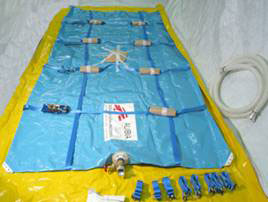KIT, WATER TANK, 5 m³, flexible, transport
Valid Article
KIT, WATER TANK, 5 m³, flexible, transport
Definition
Flexible bladder tank intended for the transport of drinking water on a flat-bed truck. Could also be used for the storage, chlorination and distribution of drinking water.
Indications
The MSF supply centres provide different brands, but all of them meet the following specifications:
- Flexible "pillow shaped" tank
- Capacity: 5000 litres
- Dimensions (may vary depending on the supplier):
- ± 4.40 x 2.20 m (MSF-Logistique)
- ± 4.50 x 2.25 m (MSF-Supply)
- Liner: resistant PVC, anti UV, yellow or blue colour
- Central opening of 120 mm at the top of the tank for filling + lid
- PVC lateral distribution plug, 2" ND50 + gate valve and Guillemin coupling
- Harness to secure the tank to the truck
- MSF logo + volume indication
- Supplied with groundsheet and repair kit
Specifications
Fabric characteristics:
- Polyester Weft complex
- Density 1100 g/m²
- Construction base cloth: PANAMA 2/2, 12x12 threads/cm²
- Tensile strength: > 4500 N per 5 cm
- Minimum tearing strength: > 500 N
- Temperature resistance: -30°C to + 70°C
- Thickness: +/- 1 mm with double thickness around outlet and filling orifices.
- Waterproof quality: minimum 1 bar
Internal fabric quality:
- PVC food grade complying with European directive (2002/72/CE)- certified
- Preferably white
External fabric quality:
- UV resistant PVC
- Yellow/clear blue/dark blue colour. Opaque
Instructions for use
For water storage
The tank prevents evaporation and protects water from pollution. It can be used for water storage, chlorination and distribution, not for sedimentation.
Choose a site for the installation
- A water tank must be installed on an even, stable and horizontal platform, accessible under all circumstances and at all times to be able to fill it
- A filled tank is heavy and needs to be installed properly at a safe location where it can't cause accidents (e.g. filled tank rolling down a slope, collapse of a building under the weight of a filled tank installed against a wall or on top of the roof…)
- The choice of the site should always be discussed with the different stakeholders
Gravity water distribution requires the "MODULE, WATER DISTRIBUTION" (see related articles below). The water tank should be located at least 1.2 meter above the level of the tap stand located close by (higher if possible) to obtain a correct flow.
Water distribution can also be done without gravity, by means of a hand pump (contact your technical department for further information).
When the water tank is installed on an earth embankment, protect its slopes from erosion with grass, stones or plastic.
Always put the water tank on its groundsheet to protect it against punctures.
Protect the tank from direct exposure to the sun by means of a roof or a shadow net.
Fence the area around the water tank.
For water transport
Use only a truck able to carry at least 5 tons = 5 m³.
DRIVE SLOWLY!
Caution, the tank is not compartmentalized: water movements within the tank can destabilize the truck.
Always firmly secure the tank to the truck using the harness.
Remove any sharp object (nails, splinters...) from the platform, and place the tank on its groundsheet.
Caution
Clean and let the tank dry completely inside and outside before storing it back. Talcum powder can help to absorb the last of the humidity.
For more detailed information and instructions see also "Public Health Engineering in Precarious Situations", MSF, 2nd edition, 2010:
- T.B. 2.34 Water trucking
- T.B. 2.35 Emergency water tanks
- T.B. 2.36 Installation of flexible reservoirs
- T.B. 2.37 Cleaning of flexible reservoirs.


![[CWATASSYV01] ASSEMBLY ball valve + elbow + reducer, 2"-¾" + half-coupling](/web/image/product.template/550141/image_256/%5BCWATASSYV01%5D%20ASSEMBLY%20ball%20valve%20%2B%20elbow%20%2B%20reducer%2C%202%22-%C2%BE%22%20%2B%20half-coupling?unique=f92beb2)
![[CWATCSEMP2IC] (symmetrical half-coupling) PLUG, 2" + locking ring & chain](/web/image/product.template/552023/image_256/%5BCWATCSEMP2IC%5D%20%28symmetrical%20half-coupling%29%20PLUG%2C%202%22%20%2B%20locking%20ring%20%26%20chain?unique=de64fcc)
![[CWATHOSS2086H] SPIRAL HOSE, 2", NP6, 8m + 2 half-couplings + lock](/web/image/product.template/545999/image_256/%5BCWATHOSS2086H%5D%20SPIRAL%20HOSE%2C%202%22%2C%20NP6%2C%208m%20%2B%202%20half-couplings%20%2B%20lock?unique=5c35d24)
![[CWATTANKF01L] (flexible water tank =<15m³) LID](/web/image/product.template/546929/image_256/%5BCWATTANKF01L%5D%20%28flexible%20water%20tank%20%3D%3C15m%C2%B3%29%20LID?unique=2bc9728)
![[CWATTANKF05] WATER TANK flex., 5m³ + 2" gate valve + lid + harness](/web/image/product.template/546949/image_256/%5BCWATTANKF05%5D%20WATER%20TANK%20flex.%2C%205m%C2%B3%20%2B%202%22%20gate%20valve%20%2B%20lid%20%2B%20harness?unique=be38ffc)
![[CWATTANKF05C] (flexible water tank 5m³) CATCH TIGHTENER + hooks](/web/image/product.template/546844/image_256/%5BCWATTANKF05C%5D%20%28flexible%20water%20tank%205m%C2%B3%29%20CATCH%20TIGHTENER%20%2B%20hooks?unique=be38ffc)
![[CWATTANKF05G] (flexible water tank 5m³) GROUNDSHEET](/web/image/product.template/546952/image_256/%5BCWATTANKF05G%5D%20%28flexible%20water%20tank%205m%C2%B3%29%20GROUNDSHEET?unique=be38ffc)
![[CWATTOOLH23] HOOK SPANNER, 2"-3", for Guillemin coupling](/web/image/product.template/546624/image_256/%5BCWATTOOLH23%5D%20HOOK%20SPANNER%2C%202%22-3%22%2C%20for%20Guillemin%20coupling?unique=e0ce1ea)
![[PHDWROPE05P] ROPE, polypropylene, Ø 5mm, twisted, per metre](/web/image/product.template/549985/image_256/%5BPHDWROPE05P%5D%20ROPE%2C%20polypropylene%2C%20%C3%98%205mm%2C%20twisted%2C%20per%20metre?unique=7f72220)
![[PSAFTAPEB52] TAPE BOUNDARY MARKING, 500m, white/red, roll](/web/image/product.template/548651/image_256/%5BPSAFTAPEB52%5D%20TAPE%20BOUNDARY%20MARKING%2C%20500m%2C%20white-red%2C%20roll?unique=7a5f50c)
![[PTOOBUILPMTH] PICK-AXE mortise axe type, with handle](/web/image/product.template/549749/image_256/%5BPTOOBUILPMTH%5D%20PICK-AXE%20mortise%20axe%20type%2C%20with%20handle?unique=ae98b10)
![[PTOOBUILSH-] SHOVEL with handle](/web/image/product.template/551479/image_256/%5BPTOOBUILSH-%5D%20SHOVEL%20with%20handle?unique=62cbd4e)
![[KWATMTANRT-] (flexible water tank) TEMPORARY REPAIR module](/web/image/product.template/551920/image_256/%5BKWATMTANRT-%5D%20%28flexible%20water%20tank%29%20TEMPORARY%20REPAIR%20module?unique=ee74eeb)
![[CWATTANKFRS] (flexible water tank) REPAIR SET, dangerous goods, set](/web/image/product.template/546936/image_256/%5BCWATTANKFRS%5D%20%28flexible%20water%20tank%29%20REPAIR%20SET%2C%20dangerous%20goods%2C%20set?unique=2bc9728)
![[KWATMDIS01W] MODULE, WATER DISTRIBUTION, 2 ramps x 6 taps](/web/image/product.template/551993/image_256/%5BKWATMDIS01W%5D%20MODULE%2C%20WATER%20DISTRIBUTION%2C%202%20ramps%20x%206%20taps?unique=60e3982)